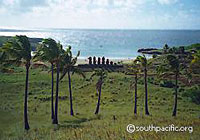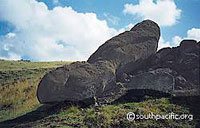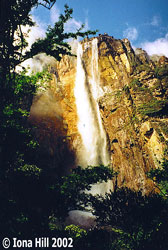And gets propositioned on the way… read on!
I got to Buenos Aires in pouring rain from sunny London
without mishap. My hotel was ok, in the historic area of
Buenos Aires and cost around £12 a night for bed and
breakfast, and it has a bathroom too, so not bad. This is a
good time to visit Argentina as prices are very low – most
meals are under £5 and a giant bottle of beer just £1! I
wanted to visit a tango show last night but was just too
tired around midnight, the time it is all supposed to kick
off. Plan to take a city tour of Buenos Aires.
Went to a place called Puerto Madero and it reminded me
of all the regeneration that has taken place in Docklands
in London. There were very few people and a lot of brand
name American eateries, so, I was a little disappointed. I
walked back to town where the real people live, but my poor
feet hurt after that! On the plus side, it could be
classified as training for my forthcoming Patagonia
trekking!
The local beer is good and it is now sunny, in sharp
contrast to the day I arrived, so prospects are promising.
Then headed by bus to El Calafate in Argentina. I am having
great weather – sunny, dry unusually windless, and hot,
even by my standards! I was even down to a plain shirt and
wished I had packed my sandals. I did a 8-9 hour trek from
a place called Refugio Pehoe on the lake of the same name
(pronounced correctly as “pewe”. to glacier
Grey. It was a very scenic walk compared to the one done
the other day to Torres (or more accurately
“torture”. del Paine which is featured on the
all of the postcards here. I reckon this one was a bit
tougher than the Machu Picchu trek in Peru, although that
was nearly 5 years ago and my age is definitely beginning
to show in my knee joints. Maybe it’s just a matter
of time before I start considering Saga holidays!
We met some travellers who had to forego their plans as
there was no accommodation at the next two destinations we
are heading to, the only other option being to set up your
own tent! Having roughed it for the last two nights I am
not ready for a repeat performance. The alternative was 180
US dollar per night hotel with everything priced in good US
$ – the cheapest item on the menu being a coca cola at only
$4! Taking of prices, I was shocked at the London prices of
everything in the Torres Del Paine National Park. Still, it
didn’t stop me from having 2 bottles of Chilean red
last night at £8 each. The idea was to stun myself into a
deep slumber in the tent and not notice the gale winds and
rain.
One thing I have been disappointed about is not being
able to gaze at the night southern sky. Chile has some of
the best skies for star gazing – but it has been too
cold or too cloudy or both! I am beginning to feel quite
worn out now and looking forward to taking a hot shower and
sleeping in a proper bed! Sleeping bags are not for people
like me who toss and turn and sleep in the spread-eagle
position!
On a bus from Puerto Natales, I met an unemployed doctor
from Spain. As a result of having a fluent Spanish speaker
on the team, we were able to find a hotel room very quickly
and cheaply, and sorted out our transport – or more
accurately dis-sorted! I decided to abandon my very much
desired plans to go on into Chile via Coyhaique and head
north through to Puerto Montt on the scenic Carretera
Austral, now nearly completed, connecting the upper part of
Chile to the remote Southern part. This is a lasting legacy
started by General Pinochet. It is said that he wanted it
named after him but this was met with a fair amount of
opposition.
From Puerto Montt, in Chile, we went to the small but
pretty and very touristy, town of El Calafate in Argentina.
We visited the Perito Glacier, (a natural wonder that grows
by 2m a day) almost immediately after we arrived. It was
hot and baking there, but a bus ride one hour later, it was
rainy at the glacier. This is Patagonia, so the weather
remains ever changing after all! Our Spanish doctor refers
to El Calafate as a “tourist trap”. apart from
the Perito Moreno, there are other excursions but all
priced in US $ and upward of $200! We could move on to our
next planned destination of Fitzroy, another “must
see” place, but nothing to move on from there til
Saturday when we head for the Chilean border once again –
and then there is no way of connecting to the Carratera
Austral with any certainty!
So, the three of us decided to leave town and take a
plane, considerably cheaper than taking the bus over 4 days
to Bariloche – another very touristy place renowned for its
Swiss like setting and more importantly for me, chocolates!
We rented a car at Bariloche airport and although not
planned, we managed to tour the whole of the Argentinean
lake district in 24 hrs – something that would normally
take at least 3 days! With our Spanish doctor friend, we
did some intense travelling and did not sleep in the same
bed twice. When we all split, I missed our new
friend’s animated conversation: drink coffee …
dug.. dug… dug…, visit x click, click, click….. and
his favourite phrase: “we have 2
possibilities”…. to which I would reply:
“what about?” The response would be: “we
have 3 possibilities… you decide”. He had all
makings a 1st Division civil servant or indeed Local Govt
officer, if only he could make decisions! We became good
mates and did a list of countries we will travel together
in the future – almost all except Britain and USA! A real
Globetrotter in the making, rucksacks and only economy
class for the “authentic experience” – not sure
if it meant not hiring cars!
I did things not “programmed” like hire
cars, and which our Spanish doctor friend drove like an
aspiring Italian Grand Prix driver in a red Fiat Punto
replica. This even gave time to visit the island of Chiloe,
S America’s 2nd largest) – did in half a day (instead
of whole day) by special negotiation. The place where we
stayed In Castro also did the tours, ran the Tourist
office, the taxi company ..the lot!
Arrived back in Buenos Aires – in broad daylight in
sharp contrast to the previous week when (thanks to Taris
our Spanish travel companion and now fast friend) we seemed
to be getting to our destinations in the middle of the
night with no accommodation fixed! It was a bit of a relief
to be in BA after a 15 hr
bus journey (very comfy sleeper – got up fresh as a daisy
and wished our air flight had been of the same standard –
meals, night cap fizzy champagne etc. from Neuquen
(Arg).
This time in BA, we
opted to stay in the slightly posher part of town. I
didn’t realise the unexpected benefit until we left a
Thai restaurant about 1am. We ran into a stunning,
vivacious, voluptuous raven-haired beauty who we initially
mistook to be a typical friendly Argentine but she made
proposals about providing massage and other services by
gesticulation as we didn’t understand Spanish, but we
got the drift all right!
One of my travel companions muttered something about
going to sleep as he was dog tired whereas I tried to
explain that my Redbridge Council zero-budget (Hem is a UK
civil servant!) for entertainment and socio-economic
research would not allow such indulgences. Only moments
earlier I was reflecting on the night time economy as the
Environmental Executives of BA municipality, who were furiously
flushing the pavements and clearing garbage just yards
away. And then to be presented with this provocative
proposal – my thoughts of returning home had me
thinking of gaps in the Skills Matrix, the reliability of
National workforce data with excluded key sector
professionals in the all important tourism and culture
industry; was she entitled business start up advice and
grants, etc, etc – enough of work talk.
On serious note: life is pretty tough for most people
after the near-collapse of Argentina’s economy 3 yrs
ago and a great many try and cope with everyday life by
doing two or three jobs and even reverting to desperate
means.
Not one for taking taxis for the “authentic
experience”, I found myself taking the underground
metro. It was amazing to find that that TV screens
suspended over the platforms showing all kinds of stuff
– one in particular was a Miss Brazil (previous night
I am sure it was Miss Argentina) parading on a catwalk
– starting with a glasses, full business suit and the
mandatory army officer hat – starting to strip of
each apparel at a time – Did she take everything off?
No Se, I don’t know. I was on the fast and frequent
train by the time she got down to her essentials! Visit
Argentina – its a great place to enjoy yourself !
Discus this article and give feedback in our online forum

 The first morning after arrival, I suggest
you climb Easter Island’s most spectacular volcano, Rano
Kau, where Orongo, a major archaeological site, sits on the
crater’s rim. But rather than marching straight up the main
road to the crater, look for the unmarked shortcut trail
off a driveway to the right just past the forestry station
south of town. It takes under two hours to cover the six km
from Hanga Roa to Orongo, but bring along a picnic lunch
and make a day of it. (If climbing a 316-meter hill sounds
daunting, you can take a taxi to the summit for around US$6
and easily walk back later in the day.) Once on top, you’ll
find hiking down into the colourful crater presents no
difficulty. It may also look easy to go right around the
crater rim, but only do so if you’re a very experienced
hiker and have a companion along as shear 250-meter cliffs
drop into the sea from the ridge.
The first morning after arrival, I suggest
you climb Easter Island’s most spectacular volcano, Rano
Kau, where Orongo, a major archaeological site, sits on the
crater’s rim. But rather than marching straight up the main
road to the crater, look for the unmarked shortcut trail
off a driveway to the right just past the forestry station
south of town. It takes under two hours to cover the six km
from Hanga Roa to Orongo, but bring along a picnic lunch
and make a day of it. (If climbing a 316-meter hill sounds
daunting, you can take a taxi to the summit for around US$6
and easily walk back later in the day.) Once on top, you’ll
find hiking down into the colourful crater presents no
difficulty. It may also look easy to go right around the
crater rim, but only do so if you’re a very experienced
hiker and have a companion along as shear 250-meter cliffs
drop into the sea from the ridge.
 Easter Island’s moderate climate and scant
vegetation make for easy cross country hiking, and you
won’t find yourself blocked by fences and private property
signs very often. You could also tour the island by
mountain bike, available from several locations at US$10 a
day. If you surf or scuba dive, there are many
opportunities here. A minimum of five days are needed to
see the main sights of Easter Island, and two weeks would
be far better. The variety of things to see and do will
surprise you, and you’ll be blessed with some unforgettable
memories.
Easter Island’s moderate climate and scant
vegetation make for easy cross country hiking, and you
won’t find yourself blocked by fences and private property
signs very often. You could also tour the island by
mountain bike, available from several locations at US$10 a
day. If you surf or scuba dive, there are many
opportunities here. A minimum of five days are needed to
see the main sights of Easter Island, and two weeks would
be far better. The variety of things to see and do will
surprise you, and you’ll be blessed with some unforgettable
memories.
 I was there 2 ½ years ago or so. It was not possible to
visit the Angel Falls independently, so we had to join a
tour. The land is owned by the indigenous people, and they
run the tours. We flew from Caracas to Ciudad Bolivar and
then on to Canaima. From there, we joined about 6 others
and took a succession of curiaras, supremely uncomfortable
dug out canoes, but powered by outboard motor, up the
river. The water is an interesting brown colour – the
colour of tea with all the tannin from the land. We ended
up on Rat Island, along with 100 or so other people all in
different groups, and spent the night here (Isla Ratton
– aptly named) which consisted of about 100 hammocks
strung out in the open under a corrugated iron roof (no
sides) and very primitive bathrooms, hurricane lamps etc. A
very early start the next morning, bread and strong black
coffee, for a short walk/climb – not at all
strenuous, to a viewing point across which we saw the Angel
Falls. The entire group sat on ledges etc gazing across at
the Falls for about 30 minutes, took photos and then went
back down the mountain and returned by curiara to
Canaima.
I was there 2 ½ years ago or so. It was not possible to
visit the Angel Falls independently, so we had to join a
tour. The land is owned by the indigenous people, and they
run the tours. We flew from Caracas to Ciudad Bolivar and
then on to Canaima. From there, we joined about 6 others
and took a succession of curiaras, supremely uncomfortable
dug out canoes, but powered by outboard motor, up the
river. The water is an interesting brown colour – the
colour of tea with all the tannin from the land. We ended
up on Rat Island, along with 100 or so other people all in
different groups, and spent the night here (Isla Ratton
– aptly named) which consisted of about 100 hammocks
strung out in the open under a corrugated iron roof (no
sides) and very primitive bathrooms, hurricane lamps etc. A
very early start the next morning, bread and strong black
coffee, for a short walk/climb – not at all
strenuous, to a viewing point across which we saw the Angel
Falls. The entire group sat on ledges etc gazing across at
the Falls for about 30 minutes, took photos and then went
back down the mountain and returned by curiara to
Canaima.